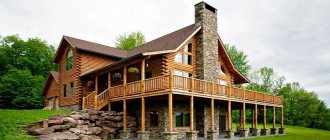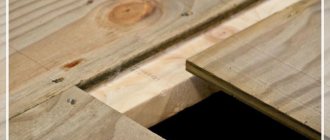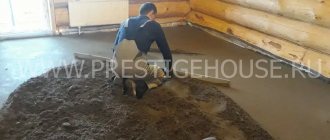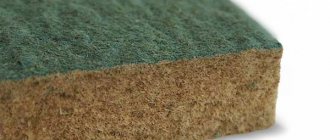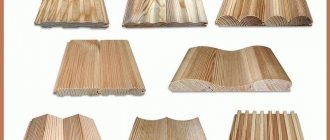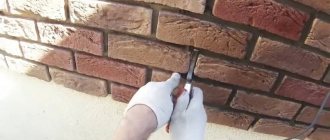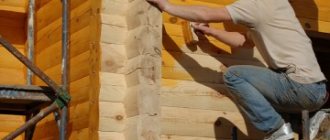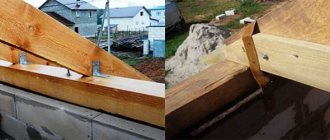Correctly building a log house designed for several generations of residents or users is not all. Only caulking of a log house, carried out in compliance with the tricks and discoveries invented by the masters of old times, will make it possible to erect a log house that, after 150, 200, or even 400-600 years, will remain suitable for its intended use. The subtleties of caulking technology for wooden structures have been developed by carpenters in northern countries for centuries. This publication is an attempt to bring together those of them that have survived to this day. Maybe, following it, you will guess something about caulking that your grandfathers and great-grandfathers knew.
Take a look at fig. below. Residential buildings on it are more than 200 years old. The hut on the top left is definitely larger - it is an exhibit in the Suzdal Museum of Wooden Architecture. And those in the bottom row were restored using modern methods. And all these buildings are still suitable for housing; those that are not museums are inhabited. Because their builders knew not only how to select and prepare logs and build from them, but also how to properly caulk the frame.
Ancient log houses
Caulking a wooden frame with your own hands is quite painstaking and tedious work, although technologically it is not difficult. Individual wooden construction is being revived, and log houses are in demand due to their high consumer qualities; a real Russian bathhouse is built only with chopped wood. However, the standard service life of a wooden house is 40 years; real - up to 60-70 years. The standard service life of a wooden house has been adopted based on mass construction using standard technologies; The generally accepted caulking technology is also adapted to them, see for example. video:
Caulking technology and methods
Two classic ways to fill inter-crown seams – caulk “set” and caulk “stretched”
Wide seams are caulked using the “set” method. The insulation is formed in the form of flat loops and the inter-crown cracks are filled with them tightly, completely, until the insulation enters.
With the “stretch” method, insulating materials are slightly stretched along the fiber in the form of a sheet, and a special tool called a caulk is pushed into the gaps between the crowns. The insulation sheet remaining outside the gap is rolled up with a roller and driven tightly into the gap.
The most difficult thing to caulk is the corners of the house, due to cramped conditions and inconvenience of work. But it is in the corners that you should caulk especially carefully, since the corners are the main cold bridge of a wooden house, and are blown even more than window openings.
The technology is simple, but the work is very long and painstaking. It’s not difficult to master caulking; the point is to fill the seams with insulation as evenly and densely as possible, and the skill, as usual, comes along the way. Caulking is carried out using heat. They start working from the lower crowns, from the very bottom. Fill the seam, passing it around the entire perimeter, first from the inside and then from the outside. After passing the perimeter of one crown twice, you can proceed to the next crown, and so on for the entire frame. Under no circumstances should you caulk walls and corners in sections, or one wall or partition at a time. This can distort the entire frame. The shrinkage of the frame is uniform, but caulking can create uneven rises of the crowns, ultimately leading to a general uneven deformation.
If tape insulation is used, then before caulking, carefully straighten it and lay it out along the entire length of the crown or wall. They start from the corner joint, hammering the end of the tape insulation into it, and then evenly pass along the entire perimeter of the crown, laying and hammering the tape into the gap, and thoroughly compacting it. Caulking requires great care and does not like to be rushed. The insulation strips should not be twisted, but should be wrapped in a tight, tight roller.
It is necessary to caulk a log house regardless of whether it will be finished inside or along the façade. Caulking will not only insulate the log house, but will also not prevent infection and rotting of the logs. It is unacceptable to caulk the log house only from the inside or only from the outside, for the reasons given above - this can cause distortion and deformation of the log house.
How to properly caulk a log house
Cold air will penetrate into small, at first glance, corner joints and cracks, significantly lowering the temperature in the house, and identifying such places is quite difficult. That is why such stringent requirements are imposed on the caulking of a log house made from rounded logs.
Even the smallest cracks and crevices must be filled with insulation as tightly and efficiently as possible, and caulking must be done not only outside, but also inside the log house. Although, in high-quality rounded logs there are almost no gaps left, neither outside nor inside.
Roller caulking is considered to be the most optimal for a log house made of rounded logs, since its quality and efficiency are much higher. To check how well it is carried out, it is enough to determine its rigidity.
It should be hard to the touch and cannot be pulled out with your hands, even if you try very hard. If the caulk passes this test, it means that the work was done with truly high quality, the house will retain heat well, and even with temperature changes, the insulation will not dry out and fall out.
The greatest advantage of rounded log houses is that after professional caulking, the house does not require any additional insulation.
Wood has long been known for its excellent insulating properties, but for the full warmth experience the village has to work hard.
It is necessary to carefully seal the cracks between the logs, thereby insulating the rooms from the freezing ice.
Caulking technology
All! The tool is ready. Next we do the following procedure. We have a bale of tow. We tear out a not very large beard from it and tuck it into a rope. This rope is usually about the thickness of your index finger, but can be thinner or thicker depending on your gaps. After this, we use caulk to drive the resulting rope into the gap between the logs. Here you will definitely notice that your hands are too tender and weak for such work and you will want to take a hammer to caulk more efficiently. Of course, you can do this, just don’t get carried away. You can easily stuff so much tow between the logs that it will tear the log from the log and lift the house. Don't let this happen.
Another subtlety. You can find places where logs, especially for timber, fit together with amazing precision, and you can’t not only insert tow between them, but even drive in our caulk even 5 mm. Do not delude yourself and do not strive to sharpen the tool to the level of a razor! Usually this means that, going around the wall on the other side, we will see between the same logs a gap into which a palm fits! This is a very typical case when the beam is twisted with a screw. Obviously, in this case, you should caulk from the side from which this can be done. And in general, compressing tow beyond any reasonable limits is a mistake for a novice caulker.
And finally, one last piece of advice. When it seems to you that the house is caulked, I advise you to fill the cracks between the logs with narrow slats, or even better, lay an additional strand of tow between the crack and the slats. In section, the wall will look like this:
or, if you have a house made of round logs, then this
Please note that in appearance, a caulked wall made of round timber looks warmer than a wall made of timber. It also seems to me that a log house made of round logs is better
The only advantage of timber is that a house can be built from it without being a specialist, and with only one assistant. I don’t see any other advantages of timber over logs. But this is already lyrics.
Let's talk about personal experience. Remember my neighbor who bought a house that was not only not caulked, but built without any tow at all? So, we tried the described method of caulking with slats on his house, and it worked! Then I did the same to myself and I don’t regret it.
Please note that I wrote all of my advice on the assumption that you are going to decorate your house with some kind of finishing material. If this is not the case, then a worthy completion of the caulking process would be to impregnate the tow, which is visible from the outside of the building, with oil paint. This is usually done in conjunction with painting the entire house. This way, you will protect your caulked house from being caulked by birds.
Finally, I apologize to experts and adherents of the Russian language for being too bold in using the word caulk and its cognates.
Article created 08/07/2007
Article edited 12/15/2011
Video description
The correct use of seam sealants is shown in this video:
But the first caulk is not the only one, especially when it comes to natural insulation. The logs in a wooden frame shift and rub against each other; this period can take up to 3 years, during which the walls will have to be additionally caulked. But even after shrinking, the insulation can fall out and become unusable, so it needs to be replaced as it wears out. The tools for re-caulking a log house are the same as for the first one.
Repeated caulking occurs as many times as necessary. This is a targeted procedure that corrects the situation only in the place where new cracks have appeared. It is advisable to perform it in the fall before the rains begin. Even if the shrinkage should have ended long ago, you need to inspect the house annually and update the caulk.
Materials used for caulking a log house
In order to choose the right material for caulking, you need to know the properties that it should have (or at least most of them).
These are properties such as:
- high thermal insulation performance;
- moisture resistance and resistance to temperature changes (the material works under constant atmospheric influences);
- harmless to the human body;
- resistance to processes such as rotting and mold formation, as well as “uninteresting” for rodents and parasites;
- resistance to mechanical damage;
- no pungent odor;
- relative durability (at least 20 years) while maintaining performance characteristics.
All materials used to insulate a log house are divided into two groups: natural and synthetic.
Video: lesson on proper caulking
Note: hereinafter we adhere to the following. terminology: caulk – a special tool for caulking work and also the caulking process itself; caulk – materials for caulking.
Most of today's carpenters build conscientiously. But if one of them has to dismantle an old log house made of wild logs, he will understand that it is not only inter-crown insulation that needs to be caulked. It is also a kind of “solder”, which over time “glues” the frame together into a kind of monolith, extremely resistant to operational loads, external conditions and pests. It is not always possible to “tear” an old log house for scrapping with hand tools; you have to use special equipment. And if the building is intended for a museum, it can be completely removed from the foundation, taking out the windows and removing the doors from their hinges, loading it onto a vehicle, reloading it 2-3 more times along the way, and it will arrive intact: the cambium of a wild tree with caulk form a very strong seam . Treated lumber does not “glue” as firmly, but it is sufficient for the structure to last for more than 120-150 years. This article is about how to caulk a log house for a service life exceeding the standard.
Materials for caulking
Historically, the very first material for insulating inter-crown seams was moss. Today it is used extremely rarely for these purposes, replacing it with more advanced tow, hemp, jute and flax.
Tow is a material made from waste from processing plant fibers. It is quite rough and inexpensive, but with fairly high insulating properties. It is absolutely natural and has the qualities of a natural antiseptic.
Hemp is close to tow, but less coarse. It uses exclusively hemp fibers. Hemp can be processed quite well, so it is woven into ropes and cords, and is also used in construction.
Jute (or flax-jute) has a grayish-yellow or golden color. This material is made from a mixture of flax and jute. Jute insulation is excellent for caulking wooden houses.
Linen batting is similar in characteristics to jute fabric, but is slightly cheaper. Linen has become one of the most used fabrics for filling seams due to its unique characteristics. Firstly, it is able to regulate moisture exchange, accumulating and then releasing vapor. This provides protection against fungus and insect pests. Secondly, the material is completely natural, it is made from flax and has a natural grayish color.
Insulation sheets are cut into strips of the required width and length with a small margin. It is laid in several layers depending on the density of the material and the width of the seam. The edges of the strip are carefully tucked in and also driven into the gap. A well-placed seal provides the house with not only high thermal insulation properties, but also good sound insulation.
Caulking tools
Tools for caulking walls are called caulking tools and are several types of metal or pointed wooden spatulas, as well as a wooden mallet. The wooden tool is used for straight seams; it is made from soft wood. Metal caulks are intricately curved and are used for corner joints. They hit the blade with a mallet, driving the required amount of compaction into the gap between the logs. The process continues until the elastic resistance of the material becomes noticeable.
Caulking technology
During the caulking process, the gaps between logs or beams are filled with sealing material. Work begins from the lower crown and moves around the perimeter of the house. At the same time, first the walls are caulked from the outside, and then from the inside. Particular care is taken to fill the gaps in the area of the corner connection of logs or beams. Caulking is often done in two stages: during the assembly of the log house and after its shrinkage. The first stage is called roughing and is performed to reduce the amount of work at the final stage. The second caulking is done more carefully, sometimes the crown joints are even disassembled in order to more carefully lay it with sealing material.
You can caulk the walls “in a stretch” or “in a set”. The first method is applicable to long and relatively narrow seams: fill the seam with insulation tapes, and at the end the entire layer is tacked with a tightly rolled roller. The caulking “set” is carried out in wide slots: the material is wound in a special way into a strand, from which loops are “set” for driving into the groove.
Despite the fact that the principle of caulking is extremely simple, the quality of the work performed directly depends on the experience and skill of the performer. A balance must be strictly maintained between the density of the material being driven into the seam and the effectiveness of the insulation achieved. In rare cases, too active clogging of the seal can even lead to the log slipping and the risk of destruction of the log house. If the technology is followed, then upon completion of the work the log house will “grow” by about 10-15 cm and will become much warmer.
Caulked seams retain heat well, but do not look very aesthetically pleasing. To make them attractive, they are decorated with jute rope or other materials. This additional finishing slightly increases the cost of caulking.
Cost of caulking
The price of caulking in the price lists of construction companies is most often indicated per linear meter. It is higher for houses made of logs and slightly lower for timber buildings. The final amount may differ slightly from the calculated amount depending on the characteristics of a particular object: the quality of its assembly, the type of corner joints, etc.
Cost and price range for the work performed on caulking a log house
The cost for the work performed can vary from 60 to 150 rubles. Prices for caulking are calculated per 1 linear meter. At the same time, each of the craftsmen takes into account not only the practicality of the material used, but also the technology being implemented, depending on the resulting seam between the logs or the customer’s desire for the materials used.
The height of the structure is also taken into account, which will require additional time to install scaffolding and scaffolding. The price increases starting from a building height of 1.2 - 1.5 meters. It is calculated taking into account the number of crowns up to a given height from the foundation of the building. At the same time, it is worth taking into account the number of nodes and indirect sections of walls that are present in each individual project. This also increases the cost of work. But each region of Russia has its own gradation, taking into account the demand for this type of construction and the availability of appropriate material for caulking.
| City | Price |
| Moscow | from 70 to 100 rub. |
| Saint Petersburg | from 70 to 100 rub. |
| Kazan | from 70 to 90 rub. |
| Rostov-on-Don | from 90 to 120 rub. |
| Krasnodar | from 60 to 100 rub. |
Tool for caulking at home
Before you get to work, you need to make a special tool - a caulk. It's easy to do with an axe, but I usually use a jigsaw whenever possible because I'm always afraid of chopping something off myself. Caulking is done, if you don’t rush, in exactly 10 minutes.
Here is the sequence of actions.
1. Take some scrap of board 25 mm thick and cut out the following blank:
The length of the workpiece is such that it is comfortable to hold in your hands.
2. We cut or trim it as follows:
3. Sharpen the caulk with an ax so that it forms a wedge and makes it convenient to push the tow between the logs.
How to choose a jute ribbon
Jute insulation is selected according to density, thickness and width. A high-density jute tape is laid between the crowns; when shrinking, the low-density insulation cakes more; the width is chosen according to the size of the timber; for rounded logs - according to the size of the laying groove. Experts recommend:
- Lay the edged timber with jute tape 20-25 mm thick; under pressure its thickness will be no more than 4 mm;
- For dry planed timber, use a tape 10-12 mm thick, which shrinks to 2 mm.
Intervention seams are caulked with a material of lower density; to fill cracks, jute batting with a density of 500-600 grams per square meter is used.
How to caulk a log house
During the assembly of the log house, the sealing material is spread as evenly as possible, always with fibers across the groove, while it is necessary that the thickness of the insulation is about a centimeter, and its ends protrude on both sides by at least 50 mm. A layer of insulation up to 4.5 cm thick can be laid over doorways and window frames. After completing the installation of the log house, the material is rolled into a roller and driven into the gap using a special blade - caulk
Particular attention is paid to corner connections
It is recommended to make the blade for this procedure from the same type of wood as the log house, since when made from a harder material during operation, it will inevitably damage the logs, forming chips, scratches and dents.
There are two ways of caulking: “stretched” and “set”.
Extended caulk is used, as a rule, as the first caulk when assembling a log house.
Caulk “as a set” is used for additional processing of seams after the house has given the necessary shrinkage, or to eliminate wide cracks and grooves.
It must be remembered that caulking is a very complex technological operation that requires special professional skills and extensive work experience, therefore this procedure must be performed exclusively by highly qualified craftsmen - caulkers.
Despite the presence of a number of advantages, such as environmental friendliness, good thermal insulation and reliable wind protection of a wooden building, caulking a log house also has some disadvantages.
The final touch - sanding
Caulking has not yet completed the construction of the log house until it is ready for flooring, installation of the attic floor, roof, installation of windows, doors, partitions, for finishing and equipment - it is desirable to sand the log house, but it is necessary to sand the inside. Especially - chopped from wild logs, debarked by hand.
Sanding a frame with sandpaper is extremely time-consuming, tedious, and this damages the outer most resistant layers of the wood. The frame is sanded using a hand-held universal grinder with nylon brushes. Worse - grinder with them; drive is too powerful. But the main thing here is still brushes for sanding wood, see video review:
Video: review of nylon brushes for sanding logs
Sanding a log frame with a brush is actually a controversial issue: the brush removes the bead of caulk, see fig.:
Sanding a log frame with a nylon brush
It is definitely clear that it is better not to touch the outside of the log house with a brush. However, there is a way to polish the outside of a log house - this is abrasive blasting. The abrasive used is... baking soda, which does not harm either the wood or the caulk. Of course, during your work you must observe all the safety precautions necessary for abrasive blasting. But the process itself can be carried out with a homemade sandblasting machine (sandblasting), because soft abrasive powder is used, see video:
Materials for caulking
Experts call traditional sphagnum moss the best and unsurpassed in terms of durability, insulating qualities and healing effects on residents. Other natural materials are also good for caulking - tow, jute, linen and felt (wool) insulation.
Today there is a huge selection of various polymer sealants that have the undeniable properties of excellent adhesion, strength, elasticity and durability. But for caulking a natural log house, it would be more accurate to focus on the use of natural materials.
In addition, polymer synthetics as sealants are not so durable compared to natural materials. The moss in the inter-crown joints of very old, up to a hundred years old, log houses when they are dismantled is surprising, it is so whole, dense and clean. The ability of sphagnum to quickly absorb moisture, retain it without releasing it to the wood, and just as quickly release this moisture into the air when air humidity fluctuates is amazing. Moss lives and breathes together with the log house, preserving the warmth in the house, the health of the log house, and at the same time the health of the residents. It’s not for nothing that sphagnum has been used for caulking since ancient times, and in our time this material is by no means archaic; on the contrary, moss insulation between the crowns of a log house is a sign of an eco-house.
In addition to being ecologically impeccable, moss has antiseptic qualities and prevents the development of fungus and mold between the crowns of the log house.
Polymer synthetics are lagging behind here too. Excellent adhesion to wood does not prevent moisture from penetrating into the joints, but it does prevent the escape of this moisture. This may cause the wood to rot. And over time, the elastic and adhesive properties of sealants decrease, and the process of infection of logs can accelerate.
Of all the representatives of the extensive family of mosses, two are used for caulking - swamp white sphagnum moss and green moss called cuckoo flax. Moss must also be laid when cutting a log house, laying it between the crowns, while the moss is moistened and evenly distributed over the logs of the log house, and the moss stems are placed in the transverse direction and the ends of the stems are left outside the walls by 100-150 mm, for caulking. The thickness of the moss layer should be at least 100 mm. Moss can be bought or harvested. Collecting moss is easy, but cleaning it thoroughly takes time. Soil, leaves, twigs and twigs cannot be left in the future insulation. drying moss is not very difficult, due to the properties of moss it can dry in the sun, in the shade, and even in rainy weather under a canopy.
Jute or jute fiber is very popular and in demand for insulating log houses. This material does not grow here, and therefore is not cheap. It is characterized by excellent heat protection, biostability and excellent “breathes” between the crowns, comparable in quality to sphagnum. Birds do not value jute and do not use it for nests.
An excellent insulation material that has no less ancient history than moss - natural sheep's wool. Excellent energy-saving properties, the ability to densely fill even thin cracks, high elasticity and elastic properties of wool fibers make wool the champion of caulking. Another excellent property is that when caulking seams with sheep wool, as a rule, there is no need for repeated caulking, due to the elastic properties of wool. The downside is that this insulation is expensive.
The traditional tools for caulking are considered to be a caulk - this is what the device is called - and also a mallet, a wooden or rubber hammer with a wide striker part. Various spatulas that are easy to use, often steel, are also used. You can use any convenient tool if the main task is to fill the inter-crown seam evenly and as densely as possible. For speed, small-scale mechanization tools are also used - hammer drills or electric chisels. In the right hands, any tool can be used, but the impact force of a hammer drill must be contained. Torn and twisted insulation strips and damaged logs as a result of hammering with a hammer drill are a very poor caulking method and a guarantee of future problems with the log house.
You can use an electric chisel to fill the seam, but you will still have to roll the tape by hand. Manual caulking was and remains a long and painstaking process, but the result is worth it - a warm and healthy log house.
Execution of work
Caulking of log houses or beams is a labor-intensive task that is performed entirely by hand. There are no devices that mechanize such work. This process is long and quite difficult; the master performs it only with his own hands.
Caulkers are a special specialty in wood construction. The caulking team consists of several physically resilient and strong men who perform caulking exclusively.
Since these masters are not involved in other types of work, they reach the pinnacle of mastery in their specialization and have the highest qualifications. If possible, you should definitely use the services of such a team, since everything is done quickly and with the highest quality.
It is quite clear that a team of caulkers has at its disposal the entire necessary set of tools to carry out caulking of a log house of any complexity:
- in the presence of any material for sealing the seams of the log house;
- different sizes of seams;
- different types of wood for wooden buildings;
- the need to seal seams in complex elements.
Every stage of work is important. It is impossible to neglect caulking, on which the warmth and comfort of living in the house depends. It is impossible to do without it in wooden construction.
Insulation technology for log walls
From ancient times to this day, two main technologies have been used to insulate wooden walls.
Stretching - used mainly for caulking narrow cracks:
- a strand is formed from the selected insulation, placed in the slot and pushed through with a spatula, leaving an edge of the material about 5 cm long outside;
- then a thin roll is rolled out of the insulation, which is wrapped into the left free edge of the insulation and carefully, using a chisel, hammered into the groove.
Included in the set - used for caulking large grooves and cracks between logs:
- the sealant is twisted into long strands up to 15 mm thick and wound into balls;
- then it is carefully unwound, while simultaneously hammering the material into the cracks using a caulking chisel;
- if the gaps have different sizes, then for larger ones the required thickness of the insulation is gained by twisting it into loops.
Tools for work:
- caulks (they are different: type-setting, curved, broken);
- wooden mallet or rubber mallet with a wide head.
Caulking tools have a steel blade that must be soft and smooth, otherwise it may damage the seal.
Work order:
- The caulking process itself begins from the bottom, from the very bottom crown and continues upward. It must be taken into account that caulking the seams changes the height of the log house.
- One seam must be caulked along the entire perimeter of the log house, first from the outside, then from the inside. This will avoid distortions in the walls of the house.
- Then the next highest seam is processed. And so on until the very top.
It is forbidden to caulk individual walls; this may cause the wall to deviate from the vertical.
As you can see, the process of caulking a log house is not that complicated, but it requires great care and careful execution of all operations. Then your home will be protected from atmospheric influences for many years, and the facades of the house will take on a finished look.
(Visited 868 times, 1 visits today)
Features of a wooden instrument
This tool is something like a wooden spatula. It can be made on your own. It may seem that there cannot be any special difficulties. You just need to plan a wooden blade and start insulating it. Slowly tap the instrument with a wooden mallet, sealing the seam with tow.
Some craftsmen even try to use an axe. They just try to stick the tow inside the seam.
Insulation is not an easy process. In ancient times, self-made blades of different widths and sharpness were used to perform it. But this was not entrusted to everyone, but only to a recognized craftsman.
A caulk is a tool that must have the following necessary qualities. It must be made from hardwood. If the material was unsuitable, it lost its qualities after just a couple of meters of sealed seam. The blade could become covered with burrs and become completely unusable.
If the hammer for hammering is made of metal, then the caulk must also have a metal handle.
The purpose of the application is to fill the seam as tightly as possible with insulation. When using low-quality logs in the construction of a log house, it will be necessary to seal fairly wide seams. This circumstance will allow you to fill them out without any extra effort. When finishing a log house with thin logs, you will need to use a metal device.
Using a caulking chisel
A caulking chisel is a metal version of this tool. Today you can buy it in a store without any problems. Branded products are offered by the best manufacturers.
A good quality chisel can also be adapted under certain conditions. It should not be particularly thick and have a blade less than 5 mm thick. A regular chisel is too narrow. They will have to carry out insulation for an unreasonably long time. The process will be speeded up by a 100 mm spatula. It is this device that needs to do the job. This tool is called a caulking tool.
Chisels are used to perform specific operations. They have different lengths and blade thicknesses. It is necessary when sealing seams and grooves of different sizes.
Using caulk with a hammer drill
A caulk with a hammer drill will significantly speed up the progress of work. In this case, the quality will be worse, since there is a high risk of damage to the logs of the log house. The load becomes uncontrollable. This is due to its shock nature. Manual execution requires the master to make only 1 blow per width of the blade of the device.
The insulation is placed at a given depth. Using a hammer drill involves frequent impacts that the worker cannot accurately assess. The insulation is laid unevenly, the seams are insulated poorly.
Mallet for performing insulation
A wooden hammer or mallet is simply necessary when insulating a log house. A good master with experience and significant experience usually has his own large set of mallets of various modifications. It is preferable to use a mallet of the same type of wood as the log house that needs to be caulked. This is not always essential, but it is desirable. Mallet has other names. Some masters call it a mushel, a beater.
A curved caulk will be very useful in this work. In a log house there are a large number of rounded sections, the ends of the logs. This type of caulk has a narrower blade than a flat caulk, its size is 50 mm with the same thickness of the blades of both modifications of the tool.
A road worker is also used. This tool has a fork-shaped appearance. It is necessary for forming rollers in the most convenient way. A road builder is used when caulking a log house using the stretch method. It should have a width of 170 mm. The recess in the road construction must be selected in accordance with the dimensions of the grooves. An experienced master always has at least 3 tools of this type with him. They are used for seams of different sizes.
It is equally important to have a breaking caulk on hand when caulking a log house. It is necessary to widen an excessively narrow groove. The breaking caulk has a wedge-shaped blade, which makes it possible to expand the space. It will have to be filled with material using another device.
Tow
This material is waste generated after the primary processing of natural fibers.
The logs are caulked with jute, hemp and flax tow. The properties and quality of such material are determined by the raw materials, the length of the fibers and the level of their purification. During production, tow is pressed into blocks. To use it, you need to pull a strip of material from the block, twist it into a rope and place it in the seam.
Although, it is easier to use tow sold in rolls.
In general, tow is not very convenient to work with, since it is very difficult to get an even seam. When caulking a log house, due to the high rigidity of the material, it is difficult to obtain a tight seam from the first approach. We have to resort to a repeat process.
If you decide how to properly caulk a bathhouse by choosing between moss and jute tow, then you can confidently say that it is better to choose moss, since it does not harbor fungus and bacteria.
Comparison of tow with other types of insulation
| Material | pros | Minuses |
| Tow | · Low cost. · Environmental friendliness and durability. · Resistant to moisture, temperature changes, weather conditions. · Does not cause allergies. | Rolled tow has a fixed width of 15 centimeters. Tree parasites may appear. |
| Moss | Eco-friendly. Prevents rotting. Long lasting. It has antibacterial and antiseptic qualities. Hygroscopic, breathable. He is not afraid of temperature changes and dampness. | Attracts birds. Large labor costs when caulking. Outwardly less attractive, catches the eye. |
| Hemp hemp | · Excellent resistance to moisture and temperature changes. · Prevents rotting and fungi. | High price. Production of the material is limited. |
| Jute | Lasting. Prevents rotting and mold. It is hygroscopic and breathable. Goes well with wood. | The material is not durable. Does not tolerate strong humidity. Hard. |
| Linen felt | Convenient to use. It has excellent thermal properties. Prevents rotting and removes moisture. | High price. |
Disadvantages of caulk
1. Caulk work is accompanied by quite a lot of noise, since in order to properly compact the insulation in the crack, it is necessary to hit the blade with a special wooden hammer, so this procedure will inevitably interfere with a quiet everyday life.
2. It is also necessary to take into account that the sealing material will be pulled out of the seams by birds, which use it to build nests. Often, to distract birds from the structure, small pieces of insulation are placed nearby as bait.
3. Insects and various microorganisms can grow in the thickness of the sealing material over time; in the process of life, they destroy the insulation, which leads to the loss of its physical properties and spillage from the gaps. To avoid this problem, wooden houses are treated with special protective impregnations and coatings.
The cost of caulking a log house is an expensive job, and since this procedure must be carried out many times to obtain an optimal result, it becomes clear that the costs of high-quality processing of the structure will be considerable. You also need to remember that if the building requires primary or repeated caulking of the log house, the prices for the materials used and the work of the caulkers will depend on the design features of the house and the corner connections of the logs.
Another feature of caulking is that caulked seams, as a rule, do not look very attractive, so they often require additional decorative finishing. Linen tow, woolen felt and moss were traditionally used as sealing materials, which are distinguished by their reliability, availability and good thermal insulation. However, recently more modern tape insulation materials based on natural flax and jute fibers have appeared. Their main advantage is that when using them there is no need for double caulking, which significantly reduces construction time. That is why today the most popular is jute insulation, characterized by high strength, low hygroscopicity and excellent spinning properties.
The caulking of a log house, carried out in compliance with all technological rules, allows you to reliably insulate the structure and ensure its moisture and wind protection for many years.
Why choose jute
The reason for the popularity of jute fibers is their low price and good performance; on the Russian market, jute competes with traditional Russian flax. When the question arises: how to caulk a house made of timber, preference is increasingly given to jute. Cottages, economy class residential buildings, bathhouses and outbuildings are insulated using jute.
In the countries of South Asia, three “harvests” of jute are obtained from one plot per year with a yield of about 2 tons per hectare; Asian producers are able to fully satisfy the needs of the world market for this product; the advantages of jute material include:
- Environmentally friendly, fibers do not split and do not form dispersed dust,
- The fibrous mass is homogeneous, does not cake,
- Jute tape is compressed to 1-2 mm without disturbing the geometry,
- Jute insulation is hygroscopic, protects the log house from excess moisture,
- Jute can be used to caulk houses made of logs, beams, profiled and edged timber.
As a disadvantage, it is noted that wet jute mass can create a favorable environment for microorganisms and insects. To eliminate this drawback, manufacturers use preservative and antiseptic impregnations; you should pay attention to this when purchasing material.
Depending on the density, jute insulation is divided into tow tape, batting and felt. The material is rigid and elastic, tends to maintain its original shape, which requires attention and certain skills when using it.
Caulking rules
Caulking of a log house is carried out in two stages - immediately after construction and after some time, when shrinkage occurs. Primary (or rough) caulking can be carried out in two ways: with laying insulation during the process of assembling the walls or performing one-time work upon completion of construction.
Each log house requires high-quality caulking, which is performed in two stages
1 way
Lay the bottom row of logs on the base.
Layed logs of the log house and inter-crown insulation between them
Then the insulation is spread on top so that the ends of the material hang evenly on both sides. Next, lay the second crown, and again a layer of insulation. This is repeated until the very top of the log house. After all work on the construction of the log house is completed and the roof is installed, the protruding ends of the seal are driven into the gaps between the beams using caulking.
The result of caulking a log house
Method 2
Caulking begins after installation of the roofing system on the log house. Insulation (preferably tape) is applied to the seam of the bottom row and, using a tool, is pushed into the gaps between the logs along the entire length, leaving hanging edges 5-7 cm wide. Then these edges are folded in, formed into a roller and hammered inside the seam. Repeat the procedure in the next row and so on until the top of the structure.
The second stage of caulking is carried out after shrinkage of the log house - after 1-2 years. The selected insulation is applied to the cracks between the crowns and driven tightly inside. You should always start work from the bottom row, and be sure to do it along the perimeter of the log house.
Insulation padding
You cannot caulk one wall first, then the second, and so on. In addition, each row is caulked both from the outside and from the inside to avoid distortions in the structure. The insulation raises the frame by 5-10 cm, and its uneven distribution contributes to the vertical deviation of the walls. In some cases, the log house is caulked for the third time - 5-6 years after construction. During this time, the wood completely shrinks and new gaps form.
Gaps between crowns
There are two ways of caulking - “set” and “stretched”. The first is used to eliminate wide gaps between logs, the second is usually used during primary caulking, when the gaps are still narrow.
To work, you need tools - a set of caulking tools, a road worker and a mallet. As a rule, metal caulks are used, although many craftsmen make them themselves from hardwood.
This is interesting: Why does the stove smoke in the bathhouse?
Advice from the experts
Caulk with jute rope
- The walls of a house made of edged timber do not always have an attractive appearance; it is almost impossible to lay insulation between the crowns without unevenness, so it will not be possible to caulk the frame “string by thread”. You can decorate the facade using jute rope, which is laid over a layer of inter-crown insulation; the rope is secured with clapboard nails.
- After finishing caulking, it is advisable to treat the crown gaps with an antiseptic; the domestic drug “Neomid” is an effective remedy. The product provides long-term protection of insulation made from natural materials from rotting, fungus and insects. It has a liquid consistency and is applied with a brush.
- If the frame is sanded after shrinkage, finishing caulk is carried out last - after sanding of the walls is completed.
How to make a log house correctly
Unfortunately, without this additional procedure it is impossible to achieve a normal microclimate in a wooden house.
Our ancestors came up with an effective way to deal with uninvited “fickle” guests. To do this, write down the rope with your own hands: after the trailer structure in the house, the room is tightly packed with insulating material on a natural basis (for example, moss, hemp, yarn).
Then the wooden cottage was completely protected from the weather, and the thermally insulated seams adequately played the role of a protective “jacket”.
Until now, the ancient technology is still in process, only the tools and materials for the work have been improved.
Builders systematized this process by developing two algorithms for constructing poles.
Do-it-yourself log caulking technology
The technology for caulking a log house with your own hands is quite complex, although you can’t tell it from the outside. As we said earlier, when caulking a log house, the structure becomes 7-10 cm higher, so you need to caulk it evenly and correctly.
You should know that no finishing activities should be carried out before caulking the log house, because... during lifting of the structure they will be immediately damaged.
Proper caulking of a log house involves insulating the inter-crown space in tiers (from lower to upper). First, we caulk the very bottom joint (between the first and second crown). This must be done along the perimeter, starting from one corner and ending with it. As soon as the tier is insulated, you need to move to the overlying crown.
It should be noted that experienced builders can straighten a skewed frame using only caulking.
When caulking a log house, it is necessary to carefully hammer in the insulation at the corners, because These nodes need this the most (due to the presence of locks and complex grooves).
There are two ways to caulk a log house with your own hands: “stretch” and “set”. The first method is used if the gaps between the rims are small, respectively, the second is intended for wide gaps. Let's take a closer look at each of the methods.
Extended log caulk
To caulk a log house "expanded" you will need a strand of insulating material for the length of the entire crack. First, you need to tamp one side of the strand into the gap, then bend the other side (as shown in the picture) and carefully hammer it in with a breaking or type-setting caulk.
Extended log caulk
Log caulking “set”
Log caulking “set”
This method of caulking a log house with your own hands requires much more insulation material, but it insulates the bathhouse from the log house more efficiently. The caulking technology proceeds differently: a strand with a thickness of at least 15 mm is prepared. Next, you need to gather the strands into the loops and hammer each loop into the gap one by one (so that the strand goes across the gap, as shown in the picture). It is necessary to hammer the strand using a breaking caulk, tamping the material from above and then from below. After the strand is completely hammered into the cracks, it is recommended to make a final compaction using a road builder.
You can study the technology of caulking timber in more detail in this video tutorial:
Video lesson on how to caulk a log house with your own hands
As you can see, the technology for caulking timber with your own hands is quite difficult and requires certain work skills!
We also recommend that you read the article: waterproofing a bathhouse with your own hands!
Synthetics and sealants
Synthetic caulking is used in combination with rough jute tape, or, for “aesthetics,” with twisted white jute rope. The rough tape is placed in the grooves of the log house under caulking with sealants without wings, flush with the edges of the groove. If the logs have a Finnish groove, then the edges of the tape should lie exactly on the longitudinal cuts in the log under the edge protrusions of the groove of the upper log.
Sealants for wood are chemically neutral polyurethane: silicone is less compatible with wood in terms of mechanical and physico-chemical properties (in particular, in terms of the thermal expansion coefficient TCR), and is destroyed under the influence of even very weak acids. In turn, the silicone solvent - acetic acid - spoils the wood, so do not try to replace special sealants for wood with ordinary construction ones. Synthetics are used to caulk mainly log houses made of laminated logs and timber - their estimated service life is the same as that of glue joints of laminated lumber.
Caulking with sealants is done quickly and simply: the initial composition is squeezed out of the tube into the groove, pos. 1 in Fig.. When it has set, the seams are puttied on top with a finishing compound to match the wood, pos. 2.:
Caulking a log house and sealing cracks in logs with synthetic sealants
There is also an “ultra-modern” method of caulking log houses built without rough caulking at all: cuts are made along the seams, strands of self-expanding polyethylene foam are inserted into them and sealed with wood-like sealant, pos. 3. In essence, this is no longer caulking, because This method is suitable for buildings made of lumber without shaped grooves, assembled on dowels and impregnated with water repellents (water-repellent impregnations). In addition, it is only suitable for selected chamber-drying materials that are completely dried and settled. And then what will happen with warping from moisture during operation - we’ll wait and see: in practice, “caulk-free caulking” has so far been used for no more than 10-12 years.
Let's return to caulking, which is still caulking, albeit synthetic. Finishing compounds darken when dry, so they are selected to match the wood using test strokes on the container. But in the light, the finishing synthetic caulk fades and the walls of the log house take on the appearance shown in pos. 4. Some people, since such “decoration” cannot be avoided, order caulking seams to be glued or filled with white twisted cord. How much this adds “aesthetics and respect” to the building is a matter of taste of the owner. And there is no arguing about tastes. Moreover, about the tastes of people who believe that natural wood needs additional “refinement”.
It is much more practical to use synthetic caulk to seal gaping cracks in logs, pos. 5 in Fig. On top of the sealant, the cracks are filled with any wood putty for exterior use, and the entire structure is rejuvenated. The putty has to be renewed every 2-3 years - it also fades in the light - but this doesn’t last long, it’s not difficult and inexpensive.
Summarizing the above
The caulking of the bathhouse, according to all the rules, retains thermal energy in the bathhouse and significantly extends its service life.
Improperly carried out work on insulating a building will lead to its rapid cooling, rotting of the log house and the breeding of pests in it. Remodeling takes a lot of time, effort and material costs. Properly performed work will help increase the service life of the bathhouse. The erected structure will delight you for many years with its warmth, power and solidity.
Proper insulation of a bathhouse can be the key to its good quality and optimal heat retention. You can caulk the walls of such a building yourself, thereby significantly saving money
It is important to know well the basic rules of the process. Typically, such work extends significantly over a long period.
Note that the basic process of insulating a bathhouse has become a tradition; it is no different from the methods that were used by our distant ancestors during the reign of kings and monarchs. The process of caulking a bathhouse seems to be a complex and painstaking process that requires a lot of time and effort. Its implementation must be approached only with certain knowledge and practical work skills.
